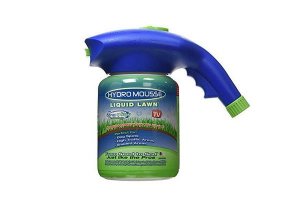Hydroseeding: How It Works
Hydroseeding involves using a hose to spray a special mixture of “water, seeds, fertilizer, cellulose fiber or wood mulch, and soil treatment agents” onto the ground.
Not only does this mixture help “shelter your seeds from sunlight, wind, and soil erosion,” they explain that it also “helps create a bond with the soil” and “releases a wide range of nutrients that help your seeds thrive” during its natural decomposition process.
Furthermore, this mixture is typically dyed green to make it easier to apply and help make it less of eyesore immediately after application, until the seed has had time to germinate and grow.
Hydroseeding was initially used for large agricultural purposes, such as restoring burned areas and controlling erosion, so it required application by trained professionals.
Recently, however, products like Hydro Mousse have entered the marketplace, promising to provide many of hydroseeding’s same benefits, but at a scaled-down size useful for residential applications.
What Seed Types Does Hydro Mousse Contain?
Other than telling us Hydro Mousse contains a “high quality” seed mixture that’s resistant to extreme heat and cold and will blend perfectly with your existing lawn, the manufacturer doesn’t provide any information about the exact species of grass seed it contains, nor the specific ingredients found in their eco-friendly slurry.
However, according to the EpicReviewGuys, the only active ingredient in Liquid Lawn’s green foaming agent is alpha-olefin sulfonate (15%), with 85% ‘other ingredients.’ The seed mix includes:
- Xtreme Green Tall Fescue 39.94%
- Corsair Kentucky Bluegrass 19.82%
- Radar Chewings Fescue 19.77%
- Academy III Perennial Ryegrass 19.55%
Are these ideal? The best seed type for your particular application will depend on a wide variety of environmental factors, such as climate and soil type, in addition to other considerations like sun/shade levels, amount of traffic, and even how short you choose to mow your grass.
With this said, Fescue grass is adaptable to a wide range of climates and soil conditions (even in drought areas), although it typically thrives in moist environments in transition zone states like AR, GA, KY, OK, MO, NC, TN, TX, and VA.
Kentucky Bluegrass has a shallower root system than fescue and typically requires a greater amount of water during the summer, although it goes dormant during the winter and requires no watering at all.
Finally, Perennial Ryegrass boasts high traffic tolerance and naturally prevents the growth of weeds, but doesn’t withstand cold temperatures well, requires a great deal of maintenance, and can crowd out other beneficial grasses and plants.
Is Hydro Mousse Liquid Lawn Effective?
Over 300 customers have reviewed Hydro Mouse on our website, giving it an average rating of 1.3 stars. While a handful of customers reported good results, in general, most complaints appeared to revolve around:
-
Difficult application – Many customers indicated the container doesn’t eject its contents properly, resulting in most of the seeds remaining in the bottom after all of the green mousse had sprayed out.
-
Spot treatment functionality – Multiple customers reported that the bottle trigger shown in the commercial isn’t functional. Instead, once you turn on your water, they indicated everything in the bottle comes out all at once (including the mousse and the seeds), which meant there isn’t an ability to spot treat.
-
Much less coverage than advertised – Many customers claimed there was only enough mousse in the bottle to cover about 20 square feet.
Additional common complaints included:
-
Inferior seed varieties – Many reviewers claimed that you could purchase similar seed mixes from local hardware stores for much less (we’ll discuss this important aspect again, soon).
-
Staining and potential toxicity – Several customers stated that Liquid Lawn stains, so be sure to wear gloves and old clothes when applying, while also taking care around driveways, sidewalks, and other concrete areas. Also, some claimed the mousse made their pets sick and/or the chemicals it contains burned their carpeting.
A Canadian network news team conducted a 14-day Hydro Mousse test in July 2014 and found that the treated area grew only in patches. However, they pointed out that an area of fresh dirt on the same piece of property filled in much better.
On the other hand, YouTuber Steve Johnson created a short four-part series examining Hydro Mousse, from initial spraying to nine days after application, and seemed to experience better results.
He even posted a follow-up video revealing that some of his leftover seeds inside the sprayer had germinated after a few days.
The Bottom Line
Most customers who left reviews about their experiences were disappointed with Hydro Mousse’s performance, whether during the application, weeks later, or both.
Many who used it to spot treat seemed to report better results than those who applied the formula to larger areas.
Furthermore, Liquid Lawn might not deliver meaningfully better results than standard bluegrass, fescue, and ryegrass seed blends, which can often be purchased locally for less than $15 and cover a minimum of 750 square feet (or, about $0.02 per square foot).


